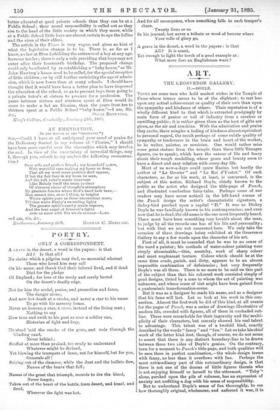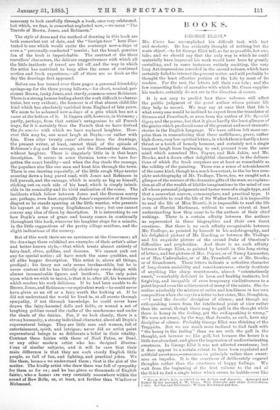ART.
THE GROSVENOR GALLERY.
IL—DOYLE.
TIIERE are some men who hold modest niches in the Temple of Fame whose tenure seems to be of the slightest ; to rest less upon any actual achievement or quality of their own than upon the sympathy and kindness of others. Their reputation is of a. wholly different kind to that which is extracted grudgingly by main force of genius or toil of industry from a careless or unwilling public ; it is rather given them as the best of gifts are given, as the air and sunshine. With the admiration and praisethey excite, there mingles a feeling of kindness almost equivalent to personal regard, the result perhaps of some subtle quality of sympathy or tenderness in the brain and heart of the worker, be he writer, painter, or musician. One would rather miss some great statues from the temple, than these little Tanagra figures, (so to speak), which have the savour of life and fancy about their rough modelling, whose grace and beanty seem to have a direct and easy relation with every-day life.
Most of us now-a-days could spare Racine, but hardly the author of "Le Grenier " and "Le Roi d'Yvetot." Of such characters, as far as his work, at least, is concerned, is the subject of this notice, Richard Doyle, chiefly known to the public as the artist who designed the title-page of Punch, and illustrated numberless fairy-tales. Perhaps some of our readers may have never noticed in the left-hand corner of the Punch design the artist's characteristic signature, a dickey-bird perched upon a capital "D." It was as Dickey Doyle he was familiarly known to his contemporaries ; and even now that he is dead:the old name is the one most frequently heard.. Theremust have been something very lovable about the man, to judge by all the records one has of his life and personality ; but with that we are not concerned here. We only take theoccasion of these drawings being exhibited at the Grosvenor Gallery to say a few words upon the character of his art.
First of all, it must be conceded that he was in no sense of the word a painter; his methods of water-colour painting were simply abominable,—thin, scratchy, work of sharp colour and most unpleasant texture. Colour whish should be at the same time crude, garish, and dirty, appears to be an almost impossible combination of deficiencies ; but very frequently Doyle's was all three. There is no more to be said on this part of the subject than that his coloured work consisted simply of good designs, tinted by a man to whom the art of painting was unknown, and whose sense of tint might have been gained from a pantomimic transformation-scene.
But it was as a designer he made his name, and as a designer that his fame will last. Let us look at his work in this connection. Almost the first work he did of this kind, at all events for the pages of Punch, was a series of drawings illustrative of modern life, crowded with figures, all of them in unshaded outline. These were remarkable for their ingenuity and the'multiplicity of their characters, but scarcely showed his real talent to advantage. This talent was of a twofold kind, exactly described by the words" fancy" and "fun." Let us take his chief work of the latter kind first, though, of course, we do not mean to assert that there is any distinct boundary-line to be drawn between these two sides of Doyle's genius. On the contrary, turn for a moment to Punch's title-page, and both qualities will be seen there in perfect combination,—the whole design teems with fancy, no less than it overflows with fun. Perhaps the most extraordinary part of this extraordinary design, is that there is not one of the dozens of little figures therein who is not enjoying himself or herself to the uttermost. " Toby " alone, perched upon the pile of volumes, has an expression of anxiety not unfitting a dog with his sense of responsibility.
But to understand Doyle's sense of fan thoroughly, to seehow thoroughly original, wholesome, and unforced it was, it is. necessary to look carefully through a book, once very celebrated, but which, we fear, is somewhat neglected uow,—we mean "The Travels of Brown, Jones, and Robinson."
But of this work there are no specimens at the Grosvenor; all the drawings there exhibited are examples of their artist's other and better-known style,—that which treats almost entirely of fairy-land, elves, goblins, and demons. We cannot pick out any for special notice ; all have much the same qualities, and all alike beggar description. This artist is, above all things, prodigal ; his fancy not only seems inexhaustible, but he is never content till he has literally choked-up every design with almost inconceivable figures and incidents. The only point upon which we wish to insist, is that it is, after all, his humanity which renders his work delicious. If he had been unable to do Brown, Jones, and Robinson—or equivalent work—he could never have given us an elf or a fairy worth the looking at. If he did not understand the world he lived in, at all events through sympathy, if not through knowledge, he could never have drawn the fairy-haunted dells and fields, or wound a net of laughing goblins round the stalks of the mushrooms and under the shade of the daisies. For, if we look closely, there is a strong humanity, a strong individual character, about all Doyle's supernatural beings. They are little men and women, full of entertainment, spirit, and intrigue; never did an artist paint supernatural beings in so deliberate a belief in their vitality. Contrast these fairies with those of Noel Paton, or Dore, or any other modern artist who has designed illustrafons of similar subjects, and it will be seen that their main difference is that they are such sturdy English little people, so full of fun, and fighting, and practical jokes. We like them, became we understand them ; that is the gist of the matter. The kindly artist who drew them was full of sympathy for them as for us ; and he has given us thousands of English fairies, whose homes are very certainly somewhere within the sound of Bow Bells, or, at least, not further than Windsor or Richmond. The style of dress and the method of drawing in this book are both somewhat out of date, and the "foreign-tour" here illustrated is one which would excite the contempt now-a.days of even a" personally-conducted" tourist ; but the broad, genuine fun of the book is imperishable. The contrast of the three travellers' characters, the delicate suggestiveness with which all the little incidents of travel are hit off, and the way in which the artist has contrived to keep alive the sense of continued motion and fresh experience,—all of these are as fresh as the day the drawings first appeared.
Before one has turned over three pages a personal friendship springs-up for the three young fellows,—for short, comical, persistent Brown, lanky Jones, and sturdy, common-sense Robinson. There is a strong human feeling about the work difficult to characterise, but very evident; the humour is of that almost child-like kind which has absolutely vanished from England of late years. We seem to be ashamed now-a-days of a grin which has not a sneer at the bottom of it. It lingers still, however, in Germany ; partly, perhaps, from that nation's antagonism to all French ways, for it is certainly from the French that we have derived the fin sourire with which we have replaced laughter. However this may be, one must laugh at Doyle,—or rather with him. Even after twenty years' absence from the drawings, the present writer, at least, cannot think of the episode of Robinson's dog and the sausage, and the illustrations thereto, without laughter. There is singularly little in it that bears description. It occurs in some German town—we have forgotten the exact locality—and when the dog steals the sausage, the populace rise like one man and hunt him through the town. There is one drawing especially, of the little rough Skye-terrier scouring down a long paved road, with Jones and Robinson in full pursuit, and the sausage, which is nearly as big as himself, sticking out on each side of his head, which is simply inimitable in its comicality and its vivid realisation of the scene. The incidents which follow between Jones and the German sentry are, perhaps, even finer, especially Jones's expression of ferocious -disgust as he stands sparring at the little warrior, who presents his bayonet at the young Englishman's nose ; but one cannot -convey any idea of them by description. It is interesting to see how Doyle's sense of grace and beauty comes in continually throughout this book, wherever his laughter stops for a minute, in the little suggestions of the pretty village maidens, and the slight indications of the scenery.



































 Previous page
Previous page